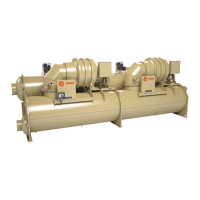CDHH-SVX003C-EN
85
Pump-out Subsystem
When the purge control subsystem detects the presence of
non-condensables in the purge tank, the pump-out
solenoid and exhaust solenoid valves open, and the pump-
out compressor turns on. The valves and the compressor
cycle on and off as needed to achieve an efficient and fast
removal of non-condensables.
Note: A High Vacuum Pump option is available for
applications that require purge operation at low
condensing temperatures and pressures. This
option provides a two-stage pump-out compressor.
The High Vacuum Pump option allows the purge
system to operate to saturation temperatures as low
as 34°F (1.1°C). Typical applications that may
require the High Vacuum Pump option include free-
cooling installations, series chiller installations, ice
systems having brine flowing through idle chillers,
chillers installed outdoors or in unconditioned
spaces, or any application that may cause very low
condenser water temperatures.
Carbon Tank and Regeneration Subsystem
The discharge from the pump-out compressor is piped
through the carbon tank. The special carbon in the tank
effectively scrubs and collects refrigerant molecules from
the non-condensable gas before the gas passes through
the exhaust solenoid valve to the chiller vent line.
A 175 W resistive heater is mounted inside the carbon tank
and is used to periodically “regenerate” the carbon bed and
drive any collected refrigerant vapor back into the chiller. A
UL-required pressure-relief valve, rated at 150 psig
(1034.2 kPaG), is mounted on the line leaving the carbon
tank. The valve protects against over-pressurization of the
carbon tank.
A temperature sensor is installed through the top of the
carbon tank shell so that the controls can monitor the
carbon bed temperature. The temperature sensor controls
the regeneration cycle and protect against overheating. If
the limit temperature is reached, the system shuts down
and a Purge Carbon Regen Temperature Limit Exceeded
diagnostic is generated.
Sensors
The following sensors are used to enable control
communication between the Symbio™ 800 controller and
the EarthWise™ purge system. The sensors use low-level
intelligence devices (LLIDs) to communicate with the
Symbio™ 800 controller.
• Compressor suction temperature sensor. This
sensor is mounted on the purge condensing unit
suction line. The controller uses the value of this
temperature sensor to decide whether or not to purge
non-condensables from the purge tank. When the
temperature drops to a specified point, the controller
activates the pump-out cycle to remove the
accumulated non-condensables from the purge tank.
When enough non-condensables have been removed
and the purge compressor suction temperature
increases in response, the controller terminates the
pump-out cycle.
• Saturated condenser temperature sensor. This
sensor is mounted on the chiller. If the chiller is running,
the controller uses the value of this temperature sensor
to adjust the purge pump-out initiate/terminate
setpoints. It may be used to prohibit pump-out if system
conditions are too cool.
• Saturated evaporator temperature sensor. This
sensor is mounted on the chiller. If the chiller is off, the
controller uses the value of this temperature sensor to
adjust the purge pump-out initiate/terminate setpoints.
It may be used to prohibit pump-out if system
conditions are too cool.
• Carbon tank temperature sensor. This sensor is
mounted in the carbon tank of the purge system. It
provides feedback to the carbon regeneration
algorithm. The sensor and the controller function much
the same as a thermostat to control the carbon tank
heater.
• Liquid level sensor. This sensor resides in the purge
control panel. It monitors the status of the normally
closed float switch, which is mounted in the bottom of
the purge tank. If an adequate amount of liquid fails to
drain from the purge tank, the float switch and sensor
detect the condition and prevent further purge
operation.
• Condensing unit LLID. This LLID resides in the purge
control panel. It uses a high-power relay to control the
operation of the purge condensing unit.
• Quad relay LLID. This LLID resides in the purge
control panel. It has four relay outputs that are used to
control the pump-out compressor, the carbon tank
heater, the regeneration solenoid valve, and an alarm
output.
• Dual triac LLID. This LLID resides in the purge control
panel. It has two triac-type outputs that are used to
control the pump-out solenoid valve and the exhaust
solenoid valve. The purge system draws its control
power from the power supplies of the chiller control
panel.
Operating Principles

